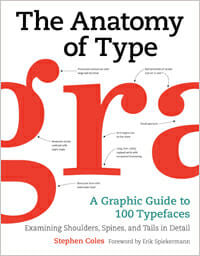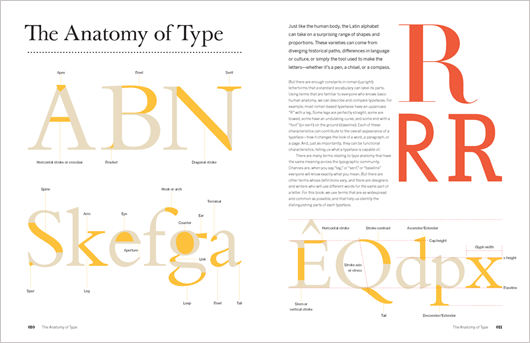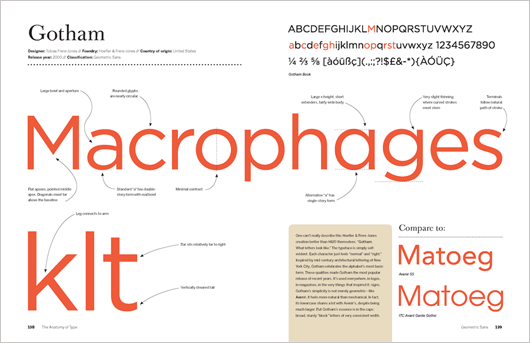Are you one of those people who is fascinated by typefaces? Since the days of desktop publishing, personal computers have come with a variety of fonts, and along with those fonts an interest in typography has become a passion for many.
 There are many great websites and blogs devoted to the typographic arts, not least of which are Typographica and FontsInUse, both run by typographer and writer Stephen Coles.
There are many great websites and blogs devoted to the typographic arts, not least of which are Typographica and FontsInUse, both run by typographer and writer Stephen Coles.
Now Coles has published a new book, a beautiful and useful hardcover from Harper Design, an imprint of Harper Collins.
The Anatomy of Type: A Graphic Guide to 100 Typefaces is a treat for any typophile.
As the press material says,
“Obsessively organized into … group classifications, this unique compendium explores 100 typefaces in loving detail, and contains enough information—from the quirky to the factual—to turn anyone into a font geek.
The full character set from each typeface is shown, and the best letters for identification are enlarged and annotated, revealing key features, anatomical details, and the finer, often overlooked elements of type design.
Containing in-depth information on everything from the designer and foundry, the year of release, and the different weights and styles available, The Anatomy of Type is more than a reference guide to the intricacies of type design.
Ever wonder how Clarendon, Didot, and Centaur came to be? Or why Gil Sans proportionally resembles olds-style serif faces, despite its inconsistent weight stress? Or who “pirated” the first font” The Anatomy of Type provides answers to these questions, and so much more…”
The design of this book, by Tony Seddon, shows the typefaces, divided into 15 categories, beautifully. Throughout the book color, size, typefaces and graphics are used intelligently and with great care on each spread.
The result allows you to simply enjoy the amazing variety of letterforms that are so similar, yet so different.
Each typeface has a paragraph about its history that includes suggested uses. First you get an illustrated primer on the anatomy of type:
Coles then introduces his 15 classifications. For instance, serif faces are divided into Humanist, Transitional, Rational, and Contemporary. Each has historical roots and subtleties you can learn to spot from the excellent illustrations.
Then it’s on to the main body of the book, 100 2-page spreads that show each of the typefaces in detail. It’s great fun to see Coles spell out the details that make one typeface different from other, similar ones, and the book is always clear.
Here’s the spread on Gotham:
What’s not to like?
Any lover of type will appreciate and learn from this book. And it’s a great gift for that type geek in your life.
As a book designer, The Anatomy of Type is appealing but incomplete. Although this is an aesthetically pleasing and informative book, typefaces don’t exist all by themselves, as they are shown here. Each is a member of a family of weights and styles.
I kept wondering what the italics for these typefaces looked like. That’s a critical component of choosing type for books; we need at least a roman and an italic, and you can’t commit to one without the other.
But that’s a small quibble when it comes to a book as useful, fun and informative as this one is.
Note that I’ve warned you it’s very easy to get lost in these beautiful pages, only to find you’ve just spent an hour comparing the shapes of the serifs on all your favorite typefaces.
Data
The Anatomy of Type: A Graphic Guide to 100 Typefaces
By Stephen Coles, design by Tony Seddon
Harper Design
256 pages, 7-3/8″ x 9-5/8″ Hardcover
ISBN: 978-0-06-220312-0
$25.99
Links to Amazon use my affiliate code.




